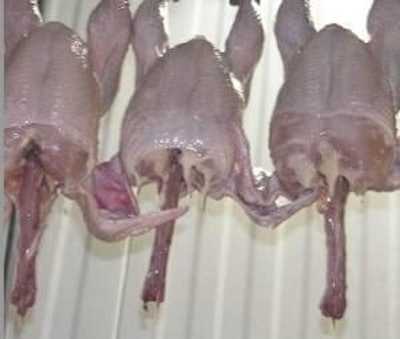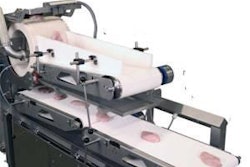
Broiler and turkey companies have moved back into the black, but with grain costs still relatively high, emphasis on cost containment is still strong. With all of the extra cost that goes into raising birds with today’s grain prices, obtaining good deboning yield, particularly breast meat yield is more important than ever. At USPOULTRY’s Processor Workshop in Atlanta this May, several processing equipment suppliers were invited to present innovative applications of their technologies. High speed automation and applications of technologies that improve deboning yields were highlighted in these presentations.
Improving breast yield
Despite improvements in automated breast deboning systems, a well managed cone line still remains the standard for maximum breast meat yield. Today’s, and likely tomorrow’s, high grain prices mean higher live costs which translate into a higher cost in each pound, ounce or even gram of breast meat.
Joe Gasbarro (see video), COO, Prime Equipment Group, said that management from Case Farms’ Winesburg, Ohio, plant approached his company with an idea they had for improving the breast meat yield on their cone lines. If the skin was removed from the shoulder of the bird before the shoulder cutters made their initial cut, would they make better cuts because they could see the shoulder joint and would this improve breast yield?
After some tests, Prime developed the CSNS-1 Chicken Shoulder and Neck Skinner.
“The machine was developed to help processors improve breast meat yield by exposing the shoulder so that the shoulder cutters can see where they are going with their knives,” Gasbarro said. For a big bird deboning operation, like the Winesburg plant, the skinner is installed on the evisceration line right after the cropper. Case Farms experienced a 0.2% improvement in breast meat yield back to live weight after the skinner was installed.
The process of removing the neck and shoulder skin also removes any left over trachea, crop, and esophagus material. The plant has also seen improvement in its salmonella test results.
If a plant does more than debone, the skinner to remove the shoulder skin can be placed after the birds have been sorted and graded out in second processing. The skinner doesn’t use peeler rollers, and it has all plastic parts.
Upgrading wishbone stamps and boney trim
Automated breast deboning systems can reduce labor needs, but this comes along with a reduction in breast meat yield. Some of the yield loss results from breast meat left on the breast frame, but other meat winds up in boney breast trimmings and attached to the wishbone. Doug Morgan (see video), director of sales and service, Baader-Johnson, discussed how the company’s soft belt separator technology allows processors to increase returns on boney trim and wishbone stamps.
Some automated breast deboners remove the wishbone from the breast frame. The wishbone and attached meat are referred to as a wishbone stamp, and stamps can weigh as much as 25 grams (1 ounce).
Plants operating multiple automated deboners on two shifts can generate as much as 20,000 pounds per day of wishbone stamps, tender clippings and boney trim.
Baader’s soft belt separator technology is 40 years old and the key components are a neoprene belt run under a perforated drum. The system separates the meat and fat from skin, bones, cartilage and tendons. Morgan said that the common drum perforation size used for poultry applications is 3 millimeters and that this yields product equivalent to meat ground through a one-eighth inch plate.
Since the Baader doesn’t crush or grind the bone the resulting “meat” can be labeled as ground chicken. The Baader system qualifies as an advanced meat recovery (AMR) system.
Morgan said that the first test of a Baader on breast deboning byproducts was at a plant with several automatic breast deboners. The plant generated 20,000 pounds per day of wishbone stamps, tender clippings and trim. This product was sent to make comminuted chicken. Running these byproducts through the Baader allowed for the resulting meat to be put into formed patties and nuggets made at the plant. This change resulted in a $20,000 per day upgrade in the product.
Faster cut-up line
Coming up with a new shackle design doesn’t sound like a real sexy innovation, but the new ACM-NT shackle allows this cut-up system to perform at up to 120 birds-per-minute. Stork Food Systems has produced a number of automated cut-up systems over the last few decades, and the ACM-NT is the latest system in this line, and its high-speed performance hinges on the new shackle.
Steve Abram (see video), regional sales manager, Stork Food Systems, explained that the typical cut-up system shackle is a “Maltese Cross” design, but that the ACM-NT shackle has an eccentric double disc assembly. Abram said that the new design gives smooth turns at higher speed while reducing carcass swings and cost of ownership. The new shackle is suspended by two trolleys and this gives less wear and tear and reduces friction on guides.
Abram said that the ACM-NT is adaptable to existing ACM modules that processors might already have. New modules have been added to the ACM family including the Crop Skin Removing Module, Wingstick Module, and the JLR-NT which is an anatomic leg module.
Narrowing the gap with cone lines
Scrape tests are an objective means of determining how much meat is left behind by a deboning process. David McNeal, product manager, Meyn Dapec, said that scrape test results from the best breast deboning cone lines can net as little as 12 to 15 grams of breast meat. Results from the worst cone lines can yield 35 to 40 grams of breast meat, according to McNeal. Automated systems have struggled to approach the results of even the poorest cone lines.
Meyn’s Rapid HQ breast deboner has a redesigned the wishbone stamping unit to reduce the amount of meat left on the wishbone. McNeal said that it used to leave 20 to 25 grams on the wishbone and that this has been reduced to 9 to 12 grams left on the wishbone. This brings the Rapid HQ’s performance closer to that of a cone line.
Meyn’s new deboner can run up to 90 wingless breast caps or “footballs” per minute. It has been designed to handle bird sizes ranging from three to 10 pounds. McNeal said that the system runs best if the breasts are sized and sorted into 0.5 pound weight ranges for each machine to maximize yield.


















